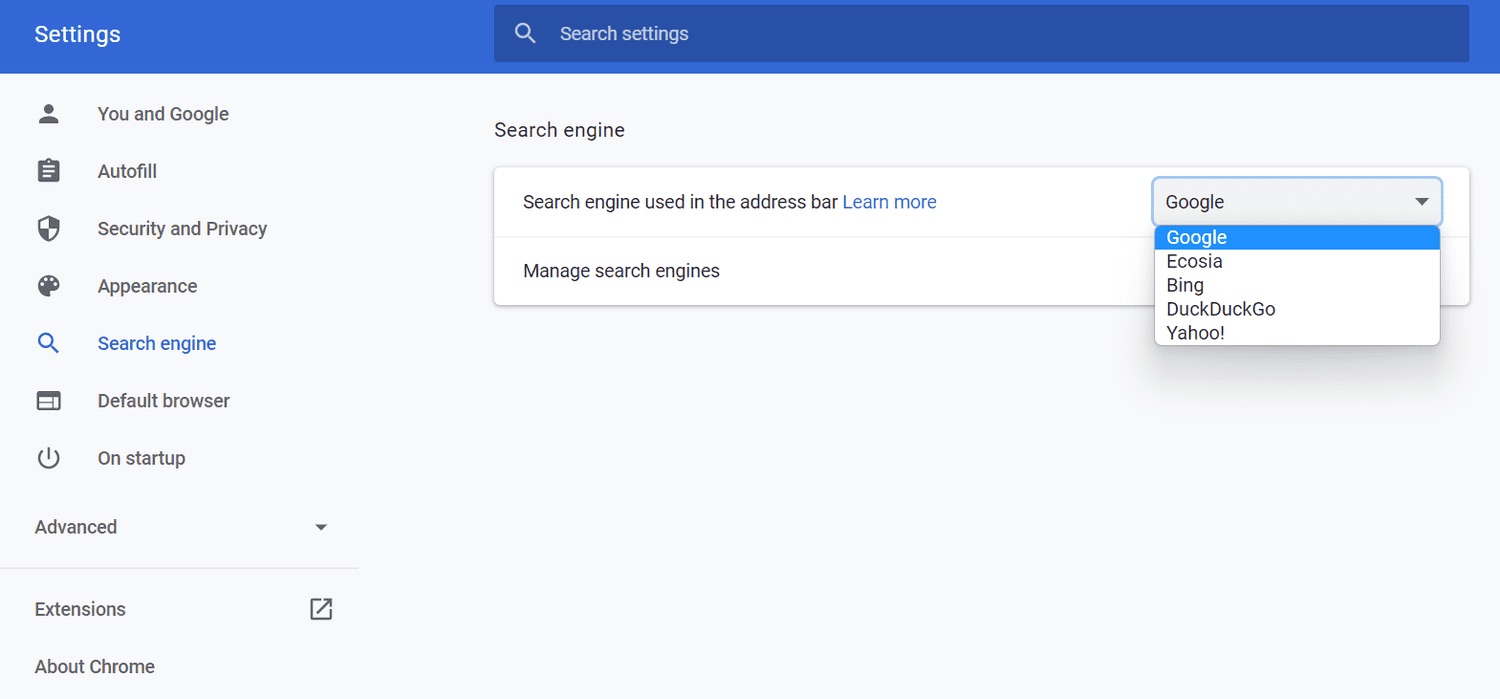Introduction
Welcome to the world of web browsing, where search engines play a pivotal role in helping us navigate the vast expanse of the internet. Chrome, one of the most popular web browsers, offers a range of features and customization options to enhance the user experience. Among these features is the ability to manage search engines, allowing users to set their preferred search engine as the default option.
However, there are instances when users may find themselves inadvertently redirected to a search engine they did not intend to use. If you've found that your Chrome browser is defaulting to Yahoo Search, despite your preference for a different search engine, fear not. In this guide, we will walk you through the steps to disable Yahoo Search Engine in Chrome, putting you back in control of your browsing experience.
Whether you're a seasoned Chrome user or just getting started with this versatile browser, understanding how to manage search engines can significantly impact your online interactions. By customizing your search engine preferences, you can streamline your browsing activities and ensure that your queries are directed to the search engine of your choice.
So, if you're ready to take charge of your browsing experience and bid farewell to unwanted search engine redirects, let's dive into the step-by-step process of disabling Yahoo Search Engine in Chrome.
Step 1: Open Chrome Browser
To begin the process of disabling Yahoo Search Engine in Chrome, the first step is to open the Chrome browser on your device. Whether you're using a desktop computer, laptop, or mobile device, launching Chrome is the initial action that sets the stage for customizing your search engine preferences.
If you're using a Windows computer, you can open Chrome by clicking on the Chrome icon located on your desktop or by accessing it from the Start menu. For Mac users, simply locate and click on the Chrome icon in the Applications folder or the Dock to launch the browser.
For those using a mobile device, such as a smartphone or tablet, locating the Chrome app icon on your home screen or in the app drawer and tapping on it will open the browser.
Once Chrome is launched, you'll be greeted by the familiar interface that serves as your gateway to the vast realm of the internet. The omnibox, located at the top of the browser window, doubles as the address bar and search bar, allowing you to enter website URLs and search queries with ease.
With Chrome now open and ready for action, you're one step closer to regaining control over your preferred search engine settings. The next steps will guide you through the process of accessing Chrome's settings to manage and customize your search engine preferences, ensuring that Yahoo Search Engine no longer takes the reins when you initiate a search.
Now that Chrome is at your fingertips, let's move on to the next step and delve into the process of accessing Chrome settings to take charge of your search engine preferences.
Step 2: Access Chrome Settings
Accessing Chrome settings is the gateway to a plethora of customization options, including the ability to manage search engines. Whether you're looking to tweak browsing preferences, enhance privacy and security settings, or modify the appearance of the browser, the settings menu is where the magic happens.
To access Chrome settings, look to the top-right corner of the browser window, where you'll find the three vertically aligned dots symbolizing the Chrome menu. Clicking on this icon will unveil a dropdown menu, presenting a range of options to explore. From here, navigate to the "Settings" option and click on it to delve into the heart of Chrome's customization capabilities.
Upon entering the settings menu, you'll be greeted by a user-friendly interface that organizes Chrome's features and preferences into distinct categories. The left-hand sidebar serves as a navigation hub, allowing you to seamlessly switch between different sections such as "Privacy and security," "Autofill," "Appearance," and more.
To proceed with managing search engines, locate and click on the "Search engine" tab within the settings menu. This will direct you to the search engine settings, where you can view and modify the default search engine, add new search engines, and remove unwanted search engines from the list.
As you venture into the search engine settings, take a moment to familiarize yourself with the available options. Chrome offers the flexibility to set your preferred search engine as the default choice, ensuring that your search queries are directed to the desired search provider. Additionally, you can explore the "Manage search engines" option to gain deeper control over the search engine list, enabling you to remove any unwanted search engines that may be causing disruptions to your browsing experience.
By accessing Chrome settings and navigating to the search engine preferences, you're taking a proactive step towards customizing your browsing environment to align with your preferences. With the groundwork laid in accessing Chrome settings, the next step will guide you through the process of managing search engines to remove Yahoo Search Engine from the equation, allowing you to reclaim control over your browsing experience.
Step 3: Manage Search Engines
As you delve into the realm of managing search engines within Chrome, you're presented with a spectrum of options to fine-tune your browsing experience. The ability to manage search engines empowers you to curate a personalized web exploration journey, ensuring that your preferred search engine takes the lead when you embark on a quest for information.
Upon navigating to the "Search engine" tab within Chrome's settings, you'll encounter a comprehensive overview of the available search engines, including the default search engine and any additional search providers you've added. This interface serves as the control center for customizing your search engine preferences, offering a seamless and intuitive platform to tailor your browsing environment to your liking.
At the heart of the "Search engine" settings lies the option to manage search engines, allowing you to wield authority over the list of available search providers. By clicking on the "Manage search engines" option, you're granted access to a repository of search engines, each accompanied by its respective keyword and URL template. This feature enables you to scrutinize the existing search engines and make informed decisions regarding their relevance to your browsing needs.
To remove Yahoo Search Engine from the list of available search engines, locate the entry corresponding to Yahoo within the search engine repository. Upon identifying the Yahoo Search Engine entry, you're presented with the option to delete or edit the search engine details. By clicking on the three vertically aligned dots next to the Yahoo entry, you can select the "Remove from list" option, effectively eliminating Yahoo Search Engine from the roster of available search providers.
As you execute this action, Chrome seamlessly removes Yahoo Search Engine from the list, ensuring that it no longer interferes with your browsing activities. This simple yet impactful maneuver empowers you to declutter your search engine preferences, streamlining the process of initiating searches and ensuring that your queries are directed to your preferred search engine without unwarranted redirections.
By managing search engines within Chrome, you're not only customizing your browsing environment but also reclaiming autonomy over your online interactions. This process aligns your search engine preferences with your individual needs and preferences, fostering a seamless and tailored browsing experience that revolves around your chosen search provider.
With Yahoo Search Engine successfully removed from the list of available search engines, you've taken a definitive step towards optimizing your browsing experience. This sets the stage for a streamlined and personalized web exploration journey, where your preferred search engine takes center stage, guiding you through the vast expanse of the internet with precision and efficiency.
Step 4: Remove Yahoo Search Engine
With Yahoo Search Engine lingering in the list of available search engines, it's essential to execute the final step of removing it to ensure a seamless browsing experience aligned with your preferred search provider. By eliminating Yahoo Search Engine from the roster of available options, you're taking a definitive step towards streamlining your browsing activities and preventing unwarranted redirections to an undesired search engine.
To initiate the process of removing Yahoo Search Engine, navigate to the "Manage search engines" section within Chrome's settings. Here, you'll encounter a comprehensive repository of search engines, each accompanied by its respective keyword and URL template. Within this interface, locate the entry corresponding to Yahoo Search Engine, which may be listed alongside other search providers.
Upon identifying the Yahoo Search Engine entry, click on the three vertically aligned dots positioned next to it. This action will unveil a dropdown menu presenting a range of options to manage the selected search engine. From the available options, select "Remove from list" to initiate the removal of Yahoo Search Engine from the roster of available search providers.
As you execute this action, Chrome seamlessly eliminates Yahoo Search Engine from the list, effectively decluttering your search engine preferences and preventing it from interfering with your browsing activities. This simple yet impactful maneuver ensures that your preferred search engine takes the lead when you initiate a search, without the intrusion of unwanted redirections.
By removing Yahoo Search Engine from the list of available search engines, you're refining your browsing environment to align with your individual preferences, fostering a seamless and tailored web exploration journey. This proactive step empowers you to curate a personalized browsing experience, ensuring that your chosen search provider serves as the guiding force behind your online interactions.
With Yahoo Search Engine successfully removed from the list of available search engines, you've taken a definitive step towards optimizing your browsing experience. This sets the stage for a streamlined and personalized web exploration journey, where your preferred search engine takes center stage, guiding you through the vast expanse of the internet with precision and efficiency.
In executing the process of removing Yahoo Search Engine, you've reclaimed control over your search engine preferences, paving the way for a browsing experience that revolves around your chosen search provider. This final step marks the culmination of the process to disable Yahoo Search Engine in Chrome, ensuring that your browsing activities align with your individual preferences and needs.
Conclusion
Congratulations! By following the step-by-step guide outlined in this tutorial, you have successfully disabled Yahoo Search Engine in Chrome, reclaiming control over your browsing experience. Through the seamless process of accessing Chrome settings, managing search engines, and removing Yahoo Search Engine from the roster of available options, you have taken a proactive step towards aligning your search engine preferences with your individual needs and preferences.
By customizing your search engine settings, you have ensured that your preferred search engine takes the lead when you initiate a search, without the intrusion of unwanted redirections. This not only streamlines your browsing activities but also fosters a seamless and tailored web exploration journey, where your chosen search provider serves as the guiding force behind your online interactions.
The ability to manage search engines within Chrome empowers you to curate a personalized web exploration journey, ensuring that your preferred search engine takes the lead when you embark on a quest for information. By removing Yahoo Search Engine from the list of available search engines, you have refined your browsing environment to align with your individual preferences, paving the way for a streamlined and personalized web exploration journey.
As you navigate the vast expanse of the internet, armed with your preferred search engine as the guiding force, you can embark on a quest for information with precision and efficiency. This proactive step empowers you to curate a browsing experience that revolves around your chosen search provider, ensuring that your online interactions are tailored to your liking.
In executing the process of removing Yahoo Search Engine, you have reclaimed control over your search engine preferences, paving the way for a browsing experience that aligns with your individual preferences and needs. This final step marks the culmination of the process to disable Yahoo Search Engine in Chrome, ensuring that your browsing activities are tailored to your liking.
With Yahoo Search Engine successfully removed from the list of available search engines, you've taken a definitive step towards optimizing your browsing experience. This sets the stage for a streamlined and personalized web exploration journey, where your preferred search engine takes center stage, guiding you through the vast expanse of the internet with precision and efficiency.
By following this guide, you've not only disabled Yahoo Search Engine in Chrome but also gained valuable insights into managing search engines and customizing your browsing environment. Armed with this knowledge, you're well-equipped to navigate the intricacies of Chrome's settings and tailor your browsing experience to align with your preferences.
So, as you venture forth into the boundless realm of the internet, may your browsing experience be seamless, tailored, and aligned with your individual preferences, courtesy of your preferred search engine leading the way. Happy browsing!

























